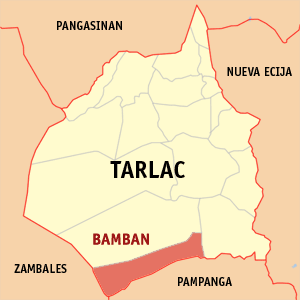Bamban: Difference between revisions
Bambanense (talk | contribs) No edit summary |
Bambanense (talk | contribs) No edit summary |
||
| Line 2: | Line 2: | ||
'''Bamban''' is a 3rd class [[Philippine municipality|municipality]] in the [[Philippine province|province]] of [[Tarlac province|Tarlac]], [[Philippines]]. According to the [[2000]] census, it has a population of 46,360 people in 9,113 households. |
'''Bamban''' is a 3rd class [[Philippine municipality|municipality]] in the [[Philippine province|province]] of [[Tarlac province|Tarlac]], [[Philippines]]. According to the [[2000]] census, it has a population of 46,360 people in 9,113 households. |
||
The municipality of Bamban is the southernmost gateway of the melting pot province of Tarlac in the Central Plain of Luzon in the Philippines. |
The municipality of Bamban is the southernmost gateway of the melting pot province of Tarlac in the Central Plain of Luzon in the Philippines. The Mount Pinatubo volcanic eruption and the subsequent flow of lava and mud to the lowlands of Bamban forced residents to move out or to stay at the Dapdap Resettlement Area, which is on higher grounds. |
||
==History== |
==History== |
||
Around 1812, Sibal [[sibling]]s from [[Pampanga]] and their families decided to look for greener pastures. They found a fertile plain bounded by the [[Parua River]] to the south, a place full of 'bamban' plants, a type of [[bamboo]]. There were 11 brothers and a sister who eventually married a Maristela gentleman from Capas. To this day, most of the people of Bamban can trace their roots to one of the 12 Sibal siblings. Bamban has had several famous sons and daughters, foremost of whom is the late Ernesto Y. Sibal, founder of Alemar's book store. Pampango or 'Kapampangan' is the main Filipino dialect spoken in the community. |
Around 1812, Sibal [[sibling]]s from [[Pampanga]] and their families decided to look for greener pastures and set their sights north of their old home. They found a fertile plain bounded by the [[Parua River]] to the south, a place full of 'bamban' plants, a type of [[bamboo]]. There were 11 brothers and a sister who eventually married a Maristela gentleman from Capas. To this day, most of the people of Bamban can trace their roots to one of the 12 Sibal siblings. Bamban has had several famous sons and daughters, foremost of whom is the late Ernesto Y. Sibal, founder of Alemar's book store. Pampango or 'Kapampangan' is the main Filipino dialect spoken in the community. |
||
==Barangays== |
==Barangays== |
||
Revision as of 07:54, 6 September 2008

Bamban is a 3rd class municipality in the province of Tarlac, Philippines. According to the 2000 census, it has a population of 46,360 people in 9,113 households. The municipality of Bamban is the southernmost gateway of the melting pot province of Tarlac in the Central Plain of Luzon in the Philippines. The Mount Pinatubo volcanic eruption and the subsequent flow of lava and mud to the lowlands of Bamban forced residents to move out or to stay at the Dapdap Resettlement Area, which is on higher grounds.
History
Around 1812, Sibal siblings from Pampanga and their families decided to look for greener pastures and set their sights north of their old home. They found a fertile plain bounded by the Parua River to the south, a place full of 'bamban' plants, a type of bamboo. There were 11 brothers and a sister who eventually married a Maristela gentleman from Capas. To this day, most of the people of Bamban can trace their roots to one of the 12 Sibal siblings. Bamban has had several famous sons and daughters, foremost of whom is the late Ernesto Y. Sibal, founder of Alemar's book store. Pampango or 'Kapampangan' is the main Filipino dialect spoken in the community.
Barangays
Bamban is politically subdivided into 15 barangays.
- Anupul
- Banaba
- Bangcu
- Culubasa
- Dela Cruz
- La Paz
- Lourdes
- Malonzo
- San Nicolas (Pob.)
- San Pedro
- San Rafael
- San Roque
- San Vicente
- Santo Niño
- Virgen de los Remedios (Pacalcal)
